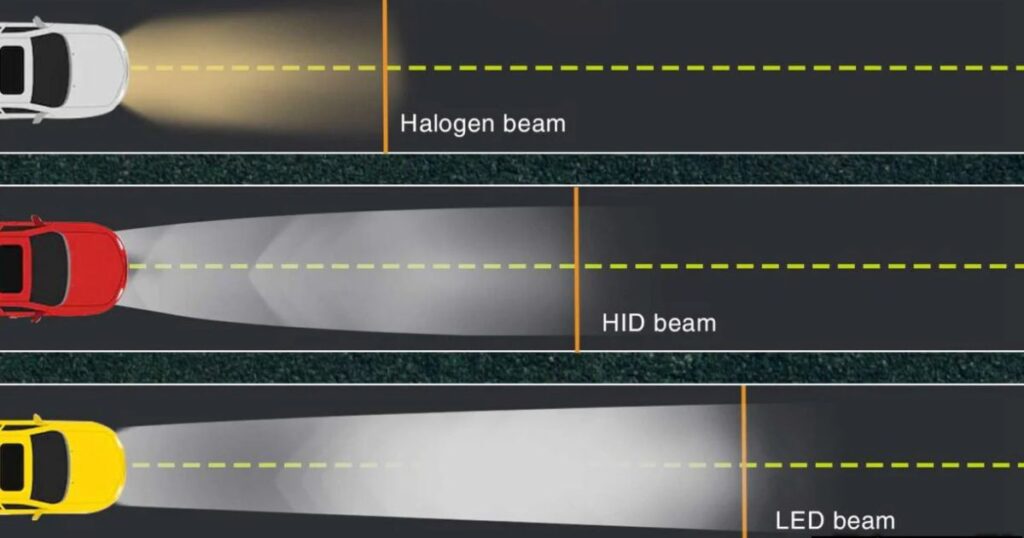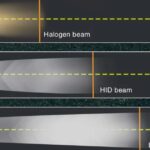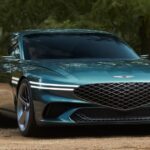Imagine driving on a dark, winding road – which headlights would you trust to illuminate your path safely? In today’s world, having quality car lighting is crucial for better visibility and safety, especially during nighttime driving or adverse weather conditions.
Among the various options available, two technologies have emerged as the frontrunners: HID (High-Intensity Discharge) and LED (Light-Emitting Diode) headlights. But which one is the best choice for your vehicle? Let’s dive deeper into the pros and cons of each type to help you make an informed decision.
Understanding HID (High-Intensity Discharge) Headlights
HID or xenon headlights use a xenon gas mixture to produce a bright, white/bluish light. The technology creates an electrical arc between two electrodes inside the bulb, igniting and exciting the xenon gas, resulting in an intense and powerful illumination.
Here are some key advantages of HID headlights:
- Superior illumination and visibility: HID headlights are up to three times brighter than traditional halogen bulbs, providing better visibility on the road and improving safety during nighttime driving.
- Long-lasting: A typical 35W HID bulb can last up to 3,200 hours, significantly longer than halogen bulbs, which means less frequent replacements and lower maintenance costs.
- Energy-efficient: While HID headlights require more energy to start up, they consume less energy than halogen bulbs, making them more energy-efficient in the long run.
However, HID headlights also have some drawbacks:
- Higher upfront cost: The initial cost of an HID conversion kit or factory-installed HID headlights is typically higher than halogen or LED options.
- Additional components required: HID headlights require additional components such as a ballast and an ignitor for proper functioning, which can complicate installation, especially in older vehicles.
- Potential for glare/blinding other drivers: If not aimed and adjusted correctly, the intense light from HID headlights can cause glare and temporarily blind oncoming drivers, creating a safety hazard.
Exploring LED (Light-Emitting Diode) Headlights
LED headlights use semiconductors that emit light when an electrical current passes through them. As the name suggests, these headlights utilize Light-Emitting Diodes (LEDs) as the light source.
Here are some notable advantages of LED headlights:
- Extremely energy-efficient and eco-friendly: LED headlights consume significantly less energy than halogen and HID headlights, making them an environmentally friendly and cost-effective choice in the long run.
- Long lifespan: With an average lifespan of up to 25,000 hours, LED headlights can last much longer than traditional bulbs, reducing the need for frequent replacements.
- Compact size and easy installation: LED headlights are smaller and more compact, allowing for better integration into modern vehicle designs. Additionally, they do not require a ballast, making installation relatively straightforward and plug-and-play.
- Stylish, modern look: Many car enthusiasts appreciate the sleek, modern appearance of LED headlights, which can enhance a vehicle’s overall aesthetic appeal.
However, LED headlights also have some limitations:
- Higher upfront cost: While more affordable than HID setups, LED headlights are generally more expensive than halogen bulbs, especially for high-quality options.
- Potential for overheating: Since LEDs generate heat, some LED headlight setups may require additional cooling systems to prevent overheating and ensure longevity.
- Not as bright as HIDs for long-range visibility: While LED headlights offer good illumination for most driving scenarios, they may not provide the same level of long-range visibility as HID headlights, especially on highways or rural roads.
HID vs LED Headlights: A Comparison
To help you better understand the differences between these two technologies, let’s compare them across several key factors:
| Factor | HID Headlights | LED Headlights |
| Illumination and Visibility | Excellent long-range visibility, up to 3x brighter than halogens | Good illumination for most scenarios, but not as bright as HIDs for long-range visibility |
| Energy Efficiency | More efficient than halogens but less efficient than LEDs | Extremely energy-efficient and eco-friendly |
| Lifespan | Typically 3,000-5,000 hours | Up to 25,000 hours or more |
| Installation and Compatibility | Requires retrofitting with additional components (ballast, ignitor) | Plug-and-play installation, no additional components are needed |
| Cost | More expensive than halogens but cheaper than LEDs upfront | More expensive upfront, but long-term savings due to efficiency and longevity |
| Appearance and Style | Bright white/bluish light, modern look | Sleek and stylish, enhances vehicle aesthetics |
As you can see, HID and LED headlights offer distinct advantages and trade-offs, making the choice highly dependent on your specific needs and preferences.
Factors to Consider When Choosing Headlights
When deciding between HID and LED headlights, it’s essential to consider several key factors:
Driving conditions
If you frequently drive on highways or rural roads with limited street lighting, the superior long-range visibility of HID headlights may be more beneficial. However, LED headlights may suffice if most of your driving is in urban areas or well-lit conditions.
Vehicle compatibility and housing design
Some vehicles may be better suited for one type of headlight over another due to their housing design and compatibility with the required components. Always check the manufacturer’s recommendations and seek professional advice if unsure.
Budget and long-term cost of ownership
While LED headlights are more expensive upfront, their energy efficiency and longer lifespan can lead to long-term cost savings. HID headlights may initially be a more budget-friendly option, but their higher energy consumption and shorter lifespan should be factored in.
Brightness requirements
If maximum brightness and long-range visibility are your top priorities, HID headlights may be the better choice. However, LED headlights could be the way to go if you value energy efficiency and a sleek, modern look.
Aesthetic preferences
Some drivers prefer the bright white/bluish light of HID headlights, while others favor LED headlights‘ sleek and stylish appearance. Consider which look best complements your vehicle’s aesthetic.
Installation and Maintenance Tips
Regardless of which type of headlight you choose, proper installation and maintenance are crucial for ensuring optimal performance and safety:
- Safety precautions and legal considerations: Always follow the manufacturer’s guidelines and local regulations regarding installing and using aftermarket headlights. Some areas may have restrictions or requirements for certain types of headlights.
- DIY installation vs. professional installation: While some LED headlight kits are designed for easy DIY installation, HID conversion kits may require professional assistance, especially for older vehicles or those with complex housing designs.
- Proper headlight aiming and adjustment: Improperly aimed headlights can cause glare and reduce visibility. Follow the manufacturer’s instructions or seek professional help to ensure proper aiming and adjustment after installation.
- Caring for and maintaining HID or LED headlights: Regular cleaning and inspection can help extend the lifespan of your headlights. Avoid touching the glass surface of HID bulbs, as oils from your skin can cause premature failure.
- Troubleshooting common issues: If you encounter problems such as flickering, dimming, or uneven illumination, consult the manufacturer’s troubleshooting guide or seek professional assistance to identify and resolve the issue.
Read Also: List Of Vehicles Over 6000 LBS That Qualify For The IRS Tax Benefit In 2024
FAQs
What are better HID or LED headlights?
There is no definitive “better” option, as both HID and LED headlights have their own pros and cons. HIDs offer superior brightness and long-range visibility, while LEDs are more energy-efficient, longer-lasting, and sleek modern-looking. The better choice depends on your specific needs and driving conditions.
Can I put LED lights in my HID headlights?
No, you cannot simply put LED bulbs into headlight housings designed for HID bulbs. The two technologies have different sizes, heat, and electrical requirements. Attempting to install mismatched bulbs can lead to safety issues, reduced performance, and potential damage to your vehicle’s electrical system.
What are the pros and cons of HID lights?
Pros of HID headlights:
- Up to 3 times brighter than halogens for excellent visibility
- Long lifespan of around 3,000-5,000 hours
- More energy-efficient than halogens
Cons of HID headlights:
- More expensive upfront cost than halogens
- Require additional components like ballasts for installation
- Can cause glare/blinding for oncoming drivers if improperly aimed
Does a LED headlight require ballast?
No, LED headlights do not require a ballast like HID headlights do. They can run directly off the vehicle’s electrical system without needing a ballast to regulate the current, which makes LED headlight installation generally simpler and more straightforward than HIDs.
Conclusion
When choosing between HID and LED headlights, there is no one-size-fits-all solution. The best choice ultimately depends on your driving needs, vehicle compatibility, budget, and personal preferences.
HID headlights offer superior long-range visibility and a bright, modern look, making them an excellent choice for those who frequently drive on highways or rural roads and value maximum illumination. However, they can be more expensive to install and maintain and may require additional components.
On the other hand, LED headlights are extremely energy-efficient, long-lasting, and offer a sleek, stylish appearance.







